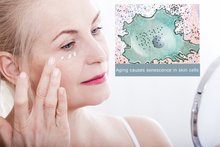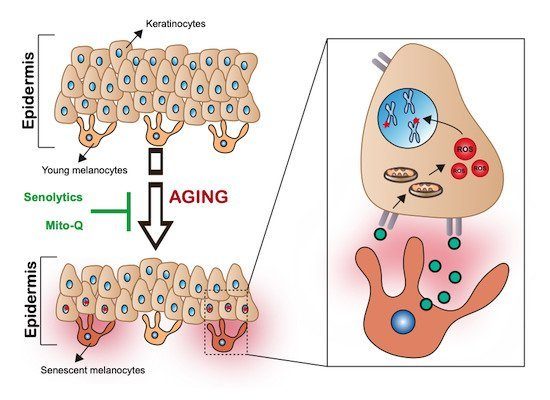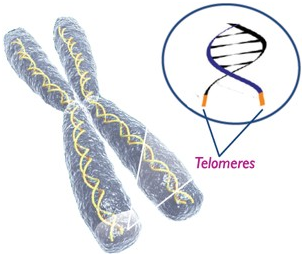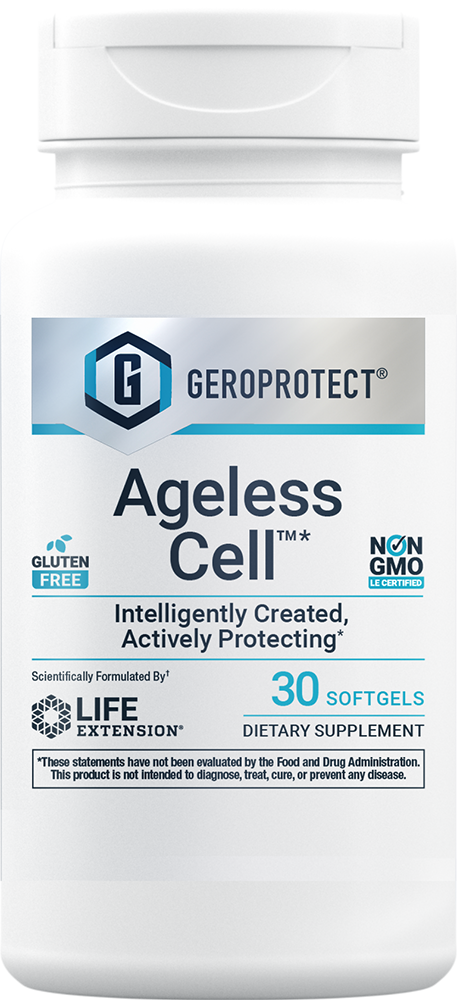How To Reverse Aging Skin – An Inside Look

When considering how to reverse aging skin work from the inside out. You must address the cellular damage that occurs in skin cells, and according to science, senolytics and a special antioxidant can help.
Inevitably, “how to reverse aging skin” is the most important thing people want to tackle when it comes to an anti-aging program, and the focus is on lotions, potions and creams that are applied on the skin.
But is that the best approach?
No, it’s not.
Lotions, potions and creams have a role in reversing aging skin, but they’re supporting actors, not the headliner. To find the star in this skin care drama you must look inside, for when it comes to how to reverse aging skin, what’s most important is what you put into your body, not on it.
Here's What We'll Cover:
First, we’re going to examine the science behind aging skin that addresses why skin ages in the first place, then we’ll look at how to reverse aging skin by seeing what can slow down or reverse some of biology behind skin aging; and finally we’ll check on what the evidence suggests are useful lotions, potions and creams that can be helpful.
Why Your Skin Ages

Two layers of the epidermis (skin) are formed by keratinocyte and melanocyte cells that become senescent. Telomeres also fray. Senolytics and MitoQ can help.
That image above comes from a 2019 study that examined how cellular senescence contributes to skin aging via an epidermal (skin) cell type called melanocytes, which is a specialized skin cell that produces the protective skin-darkening pigment melanin, and the only skin cell type to express a senescence marker called p16INK4A during human skin aging.
Along with the melanocytic layer of the epidermis, notice that the image above shows the keratinocytic layer as well. Keratinocytes represent the major cell type of the epidermis, and is the outermost of the layers of the skin, making up about 90% of the cells there.
The image also illustrates that part of what causes aging in the epidermis are senescent melanocytes.
Cellular senescence is a process that results from a variety of stresses that, in effect, creates “zombie cells”. Neither dead (cellular apoptosis) or alive (able to divide,) senescent cells accumulate during aging, and have been implicated in promoting a variety of age-related diseases, particularly because they negatively affect nearby healthy cells and promote chronic inflammation, known as inflammaging.
[Check here for more info about senescent cells]
Thus, senescent melanocytes are skin cells that have become senescent, and thereby strongly contribute to aging skin.
The enlarged image on the right indicates that free radicals also induce skin aging by shortening telomeres, those protective caps on the end of chromosomes.
 [Check here for more info about telomeres]
[Check here for more info about telomeres]
Finally, note that senolytics and MitoQ (in green) are represented to impede the skin aging process, both of which I’ll address in a moment.
To summarize, the image above shows that:
- Senescent melanocytes affect keratinocyte function and cause age-associated skin thinning because:
- Senescent p16INK4-positive melanocytes accumulate in your skin with age.
- Senescent melanocytes induce telomere damage and senescence in surrounding cells via paracrine signaling, a form of cell signaling whereby a cell produces a signal to induce changes in nearby cells, altering the behavior of those cells.
- The paracrine signalling also causes telomere dysfunction and increased free radical production.
- Clearance of senescent melanocytes may be achieved with a senolytic compound (these help reduce the number of senescent cells) and/or with free radical scavengers (these, commonly referred to as antioxidants, reduce the number of free radicals).
If you’re a science nerd, watch the video below by the impressive PhD student of biochemistry Eleanor Sheekey.
For the rest of you, learn how to reverse aging skin, the focus of the rest of this post.
How To Reverse Aging Skin With Senolytics and Fasting
Understanding why and how skin ages offers potential therapeutic opportunities to arrest further damage, and perhaps to revitalize aging skin as well.
You learned that cellular senescence and free radicals can damage and age skin, so what can address these two assaults?
First off, do your best not to further harm your skin by limiting:
- Intense physical and psychological stress,
- Alcohol consumption,
- Smoking
- Poor nutrition,
- Overeating,
- Environmental pollution, and
- Ultra violet (“UV”) exposure.
You can dive deeper into these and much, much in my three-part series, Your Battleplan To Combat Skin Aging.
Next, consider supplementing with well-researched, over-the-counter nutraceuticals.
Reduce Senescent Cells With Senolytic Compounds
UPDATE (5/7/22): As I explain here, a new study casts shade over the effectiveness of fisetin as a senolytic.
Recall that senolytics are compounds/molecules that can reduce the number of, and arrest the spread of senescent cells. Some senolytics are pharmaceutical drugs, such as dasatinib, and some are supplements available over-the-counter, such as these three:
- Quercetin, a plant polyphenol from the flavonoid group;
- Piperlongumine, a natural product derived from the fruit of the Asian Long pepper; and
- Fisetin, a flavonoid and antioxidant.
Compounds such as the above three are referred to as “senolytics”, because they arrest senescence. To reiterate, according to Wikipedia:
A senolytic is among a class of small molecules under basic research to determine if they can selectively induce death of senescent cells and improve health in humans. A goal of this research is to discover or develop agents to delay, prevent, alleviate, or reverse age-related diseases.
I explain the science behind quercetin, piperlongumine and fisetin in my post Can New Senolytics Drugs Delay Aging.
In another post, Can 4 Natural Compounds “Eliminate Senescent Cells” and Prolong Your Healthy Lifespan?, I explain more about cellular senescence, and a fourth senolytic developed by the Life Extension Foundation and Insilico Medicine (a biotech firm) called Ageless Cell.
Another category of supplements that have been shown to help with skin aging are antioxidants. Wikipedia says:
Antioxidants are compounds that inhibit oxidation, a chemical reaction that can produce free radicals and chain reactions that may damage the cells of organisms.
This is how MitoQ can help with aging skin. MitoQ is a mitochondria-targeted antioxidant. Mitochondria are the so-called “power factors” of the cell responsible for making energy for the cell, and thereby, for you.
In summary, one potentially effective way that you can address skin aging is by taking senolytics and a specific antioxidant; namely:
- Quercetin,
- Piperlongumine,
- Fisetin, and
- MitoQ
If supplements aren’t your thing, know that when it comes to arresting or reversing aging skin, hunger is your friend.
Reduce Senescent Cells By Fasting
If supplements aren’t your thing, you can also reduce cellular senescence by fasting. A 2018 study that examined how β-hydroxybutyrate “promotes vascular cell quiescence, which significantly inhibits both stress-induced premature senescence and replicative senescence…”.
Β-hydroxybutyrate is a chemical that is made by the body to provide energy in times when not enough carbohydrates have been eaten.
Longevity Technology summarizes the B-hydroxybutyrate study:
When the body fasts, or subsists on a diet low in energy-rich carbohydrates, it enters a metabolic state called ketosis. Since the body is no longer ingesting enough energy, it begins to use its fat reserves, converting them into ketones, molecules produced by the liver from fatty acids that can be used as a fuel source. One of these ketones is a molecule called β-Hydroxybutyrate and it is this molecule that has caused excitement in the Longevity field.
Thus, it appears that Β-Hydroxybutyrate has the ability to inhibit cellular senescence, and that fasting upregulates this chemical.
But how long do you have to fast?
Unfortunately, it can take up to three days of fasting to increase B-Hydroxybutyrate. But there are alternative ways of doing this. As this 2020 study shows, increasing circulating ketone bodies in your body and intermittent fasting can increase B-Hydroxybutyrate.
Ketone bodies are water-soluble molecules that contain the ketone groups produced from fatty acids by the liver. They’re readily transported into tissues outside the liver, where they eventually are oxidized for energy.
Your body produces ketones if you ingest ketone salts or esters. The main difference between the two is duration. Ketone esters give you a shorter, larger spike in ketones. Ketone salts give you a longer-lasting, more moderate spike in ketones.
On Amazon.com, the highest rated ketone ester is KetoneAid KE 4 and costs $100 for a three-day supply, and the highest rated ketone salt is Key Keto and costs $30 for 15 servings covering 15 to 30 days depending on tolerance.
If you’re considering putting yourself on a Ketone Diet, I recommend that you first read:
- The Solution To The Keto Diet Controversy
- Is The High Fat Keto Diet For You? One Woman and Three Experts Tell The Tale
In my case, I only fast for three days a couple of times a year (although I plan to do more), and have yet to try ketone sales or esters. Instead, I practice intermittent fasting (IF) most every day.
IF is yet another way to increase Β-Hydroxybutyrate and thereby reduce senescent cells. Think of IF as time-restricted eating, and as you might imagine, there are several different methods of restricting when you eat, such as:
- Fast for 16 hours, eat during the remaining 8 each day (my approach);
- Reduce calories to about 500 per day 5 days a week, fast for 2 (the so-called 5:2 method);
- Alternate day fasting; or
- Any mix of the above.
I’ve written much about IF, which you can access here.
There’s also something called “ProLon”, which is a “Fasting Mimicking Diet” developed by famed cellular biologist Dr. Valter Longo.
I just bought the kit for my 88 year-old mother and will soon fly to her home near Olympia Washington to guide her through the five-day program. To show her some camaraderie, I’ll fast two of those days, and restrict calories the other three.
[Check here for more info about ProLon]
If you’re not already a Subscriber and want to follow Mom’s progress and get my anti-aging Sunday Newsletter, subscribe here.
The Role of Lotions, Potions and Creams
For a deep dive into skin care, check out my three-part series, Your Battleplan To Combat Skin Aging. But also read on, because I’m going to add some results of three scientific studies, all published in 2016, about how to reverse aging skin, or at least slow down the damage.
The three studies:
(1) A skin brightening/anti-aging study found that “a topical cream containing retinol 0.5% in combination with niacinamide, resveratrol, and hexylresorcinol is efficacious and tolerable for skin brightening/anti-aging when used with a complementary skin care regimen including SPF 30 sun protection.”
(2) An anti-wrinkle study evaluating the effectiveness of hyaluronic-acid found that “The regular use of hyaluronic-acid containing anti-wrinkle creams for over 3 months showed clear and positive effects on wrinkle-depth and skin-tightness.”
(3) A study examining a multi-prong approach to reducing skin aging indicates that UV protective sunscreens, free radical scavengers, and chemical peeling can be effective skin aging deterrents, and mentions cell-protective agents such as B3 (niacin), as well as retinol.
Based on these findings, you might consider using these:
- Retinol
- Niacinamide (similar to niacin)
- Resveratrol
- Hyaluronic acid
- UV protection
- B3 (niacin)
- Hexylresorcinol (didn’t find a source)
But before you decide which lotions, potions, creams and supplements to take, check out a larger group of candidates in Parts 2 and 3 of my three-part series about how to reverse aging skin.
Your Takeaway
I hope you weren’t too distracted by all the science in this post. Suffice to say, the three things helpful to remember about how to reverse aging skin are:
- Apart from sun damage, skin ages from the inside out, so make sure you address skin aging on the cellular level.
- Skin cells can be supported by the supplements with the senolytics Quercetin, Piperlongumine and Fisetin, and by the mitochondrial antioxidant MitoQ.
- There are numerous lotions, potions and creams to protect and nurture the skin that contains Retinol and Hyaluronic acid; a longer list can be found here and here.
Last Updated on July 7, 2023 by Joe Garma












